Preliminary data of life history traits of Mormyridae (Actinopterygii:Teleostei) in the Upper Sanaga River, Central Region of Cameroon
Claudine Tekounegning Tiogué, Arlette Nadine Souk Ngo, Guegang Tekou,
Joseph Tchoumbouéb
aLaboratory of Applied Ichthyology and Hydrobiology, School of Wood, Water and Natural Resources, Faculty of Agronomy and Agricultural Sciences, University of Dschang, Ebolowa Antenna, P.O.Box 786, Cameroon
bLaboratory of Applied Ichthyology and Hydrobiology, Department of Animal Productions, Faculty of Agronomy and Agricultural Sciences, University of Dschang,Ebolowa Antenna, P.O.Box 222, Cameroon
Keywords:
Mormyridae
Endogenous species
Reproduction
Tropical river
A B S T R A C T
The present study on some biological aspects of the Mormyridae fishes, was conducted between May and August 2015 in the Upper Sanaga at Lékié Department (Monatélé Town), Center Cameroon.For this purpose, 125 specimens collected by local fishermen were used.Fishes were identified and measured, and their feeding and reproductive parameters were obtained after dissection.The catch composition of 4 species (Campylomormyrus phantasticus, Mormyrops anguilloides, Mormyrus macrophtalamus, Mormyrus tapirus) of Mormyridae identified in the region was very low (17%-30%).The mean ±standard deviation of total weight and total length were 103.14 ± 37.83 g and 27.47 ± 4.84 cm, respectively.The minimum and maximum size (of 21.1 cm and 43 cm)were recorded from C.phantasticus and M.anguilloides, respectively.The mean ±standard deviation of the relative length and mass of the digestive tract were 0.35% ± 0.20% and 5.27% ± 23.20%, respectively confi rming that Mormyridae fish species have a strict carnivorous diet and consume prey that are difficult to digest.The size frequency distribution of the Mormyridae fishes showed that the majority of the fish caught are small sizes in classes 23-26 cm and 26-29 cm in C.phantasticus, M.macrophthalamus and M.tapirus.M.anguilloides did not record small specimens, however, it recorded larger sized specimens (41-44 cm) compared to the rest.The sex ratio ranged from 1M: 1.14F (M.anguilloides) to 1M: 4F (M.tapirus), mean 1M: 2.04F has been generally in favour of females.The gonadosomatic index (GSI) was generally low in all species.However, it was higher in females of C.phantasticus and M.anguilloides compared to other species.The hepatosomatic index (HSI) was weakly correlated with the GSI in these species.
1.Introduction
Mormyrids (Family Mormyridae) are endemic to African Rivers and are represented by about 208 species, which belong to 18 genera(Ragheb, 2016).They are often a dominant group in many tropical aquatic habitats.Stiassny et al.(2007) provides descriptions and diagnoses for 15 genera and 41 species of the Mormyrids found in the Lower Guinea.Of these, 17 species (41%) are endemic to the region,while the remaining taxa have widespread distributions either in the Congo basin or in the Nilo Sudanic region (Stiassny et al., 2007).The Mormyridae, the African electric fishes, snoutfish or elephant fish have elongate, laterally compressed bodies and tubular snouts and they are covered with small cycloid scales (Kramer et al., 2016).As a modern radiation in an otherwise relictual group, the mormyrids are best known for their ability to generate and sense electric discharges (Bullock et al.,2005; Wiltschko & Kramer, 2009; Kramer, 2013a, b & c; Kramer et al.,2016).
In Cameroon, as others countries in Africa, natural disturbances related to climate changes, and human activities that may affect the ichthyodiversity are growing in the recent decades (Sighomnou et al.,2007).Associated with rapid population growth, the unbridled pursuit of food security leads to the degradation and destruction of aquatic species habitats (Tiogue et al., 2013).The threats of extinction of indigenous fish species are the most severe.Most of the Mainland Rivers have at least one dam on their main course for various purposes(Lévêque, 1997).The creation of these dam lakes, especially those for hydroelectric purposes, has led to numerous investigations as to their impact on the population of the original fish fauna (Bitja-Nyom & Pariselle, 2015; Mitongo, 2016; Ndzana, 2016).The immediate consequences result in a modification of the ecological conditions of the ecosystems, a regression or even the extinction of certain benthic fish species like Mormyrids (Bitja-Nyom & Pariselle, 2015; Mitongo, 2016,Nzana, 2016).Mormyridae are some of the first species to react to the slightest change in environmental conditions (Kramer, 2013a & b) and are considered as bioindicators (Scheffel & Kramer, 1997).They would therefore be the first victims of anthropogenic activities responsible for the loss of biodiversity in aquatic ecosystems.As in the Ivoiry Coast,natural resources and particularly that of Mormyridae are decreasing over time in the Sanaga River (Aboua et al., 2015).
To deal with such situations, aquaculture appears to be the only way to preserve the biodiversity of indigenous endangered species of the country.According to Tiogué (2012), the domestication of a species begins with the mastery of its bioecology in its natural biotope.
While in Cameroon many studies have been carried out in several rivers on the status and bio-ecology of various indignous fish species(Bitja-Nyom & Pariselle, 2015; Kenfack, 2012; Mitongo, 2016; Nzana,2016; Tiogué, 2012; Tiogué et al., 2010, 2013, 2020; Tomedi et al.,2014; Zango et al., 2016), no studies have been done on the Mormyridae fishes of the Upper Sanaga River.The purpose of this study is to aid in the preservation of the Mormyridae biodiversity in the Sanaga River through their domestication.Due to the lack of scientific information on Mormyridae fish species in Cameroon, especially in this River, the present study aims to aid in the preservation of Mormyridae biodiversity through domestication by providing information on feeding habits, size structure, and reproductive characteristics.
2.Material and methods
2.1.Physical environment
The study was carried out between May and August 2015, in the Central Region of Cameroon, Department of Lekié at Monatélé, the upper part of the Sanaga River (Fig.1).The geographical coordinates were as follows: 4°5′30′′and 4°9′10′′N and 11°10′30′′and 11°20′44′′E,with and average altitude of 560 m.The temperature oscillated between 22 and 32 ℃ and average 25.1 ℃.The climate was humid equatorial type with four seasons of unequal duration (Bitja-Nyom & Pariselle,2015).The rainfall varied from 1500 to 2000 mm per year (with an average of 1750 mm) and the relative humidity varied between 49% and 85.50% (Bitja-Nyom & Pariselle, 2015).The variations of all these parameters observed in recent years and caused for the most part by human activities are not without negative consequences on aquatic biodiversity.(Aboua et al., 2015).

Fig.1.Map of the Atlantic Coast of Cameroon, showing the Sanaga River Basin and point of sample collection.
2.2.Specimen
There were 125 specimens of the Mormyridae species, which were randomly collected twice a month from fishery products of Lékié fishermen.All specimens were catched by artisanal fishing techniques such as gillnets, beach seines, longlines and bottom trawls.The collected specimens were then transported in coolers to the Laboratory of Applied Ichthyology and Hydrobiology at the University of Dschang.
2.3.Data collection
2.3.1.Identification and measurements of fish
The fish were identified by the identification key of Stiassny et al.(2007), then grouped by species.The total weight (TW) was measured by electronic balance (Sartorius Competence).After measuring the total length (TL), all fishes were classified by size into different groups.
2.3.2.Morphometric characteristics of the digestive tract
Each specimen was carefully dissected.The digestive system was removed, from the abdominal cavity to the gut was cut just below the oesophagus, and end the anal orifice.The gut length (GL) and gut weight(GW) were measured on each intestine for the determination of its morphometric characteristics.
2.3.3.Reproductive characteristics
The sex of each fish was determined after dissection by nake eye examination of the gonads according to the method used by Lalèye et al.(1995).Specimens in such method were not determined sex, considered as indeterminate sex.The both sides of the gonad and liver of each fish were removed and weighed on a balance.
2.4.Parameters
2.4.1.Catch composition of samples
The catch composition of samples (CCS) of each species was calculated according to the formula of Stamatopoulos (2002):
CCS (%) =(Number of specimens per species/Total numbers of fish collected) ×100.
2.4.2.Gut morphometric characteristics
The relative gut length (RGL) and relative gut mass (RGM) were calculated using the following formula, respectively (Tiogué et al.,2015):
RGL =GL/TL, where GL =Gut length and TL =Total length of fish;
RGM =GW/TW, where GW =gut weight and TW =total body weight of fish.
2.4.3.Length frequency distribution of fish
The frequency distribution of fish length sizes was established for all specimens and based on the species and sex of the Mormyridae according to Tiogué (2012).
2.4.4.Reproductive characteristics
- The sex ratio was the number of males (M) to the number of females(F).
- Gonadosomatic index (GSI) was calculated according to:GSI(%) =(gW/TW) ×100, wheregW=gonads weight andTW=Total body weight of fish.
- Hepatosomatic index (HSI): Only females of sexual maturity stage III and IV as defined by Lalèye et al.(1995) were considered in the calculation of this index (at advanced maturation).It was calculated according to Le Bec (1983):HSI(%) =(fW/TW) ×100, wherefW=liver weight andTW=Total body weight of fish.
These two parameters (GSIandHSI) are used to determine the breeding season for a given species of fish (Tiogué, 2012).
2.5.Statistical analyses
The number of size classes was determined according to Number of classes =1+(3222 ×Ln 125) and the class range (variation of the variable) according to LTmax- LTmin)/number of classes.Regressions and correlations were established between the morphometric characteristics of the fish and those of its intestine, GSI and HSI).The χ2test compared the sex ratio of species.One-way analysis of variance (ANOVA) was performed on the gut morphometric parameters, GSI and HSI.The Tukey multiple range tests (Chen et al., 2017; Lee & Lee, 2018; Schlegel,2018) was used as a follow up procedure at the 0.001% probability level.All statistical analyses were performed using statistical software SPSS 20.0 for Windows (SPSS Inc.Chicago, IL USA).Graphs were generated using Microsoft Excel 2007.
3.Results
3.1.Catch composition of samples and morphometric characteristics of the studied species of Mormyridae in the Upper Sanaga River
The catch composition of samples and morphometric characteristics of the Mormyridae of the present study (Fig.2, Table 1 and Table 2)showed that there were four species in the upper Sanaga River, with mean total length of 27.47 ± 4.84 cm, mean total weight of 103.14 ±37.83 g, and lower catch composition of samples (<30%).

Table 1Catch composition of the Mormyridae species sample in the Upper Sanaga River,Central Cameroon.

Table 2Morphometric characteristics of Mormyridae fish species caugth in the Upper Sanaga River, Central Cameroon.

Fig.2.Mormyridae species identified at Monatélé in the Upper Sanaga River,Central Cameroon.A.Campylomormyrus phantasticus Pellegrin, 1927; B.Mormyrops anguilloides Linnaeus, 1758; C.Mormyrus macrophtalamus Gunther,1866; D.Mormyrus tapirus Pappenheim, 1905
3.2.Gut morphometric characteristics of the studied species of Mormyridae in the Upper Sanaga River
The morphometric characteristics of Mormyridae’s digestive tract(Table 3) showed that: The RGL was generally<to 1 regardless of the species or sex considered.The RGM ranged between 2% and 8% in all four identified species and regardless of sex.C.phantasticusandM.anguilloideshave recorded comparable RGL (P >0.001) and signi ficantly higher (P <0.001) than those ofM.macrophtalamusandM.tapiruswhich are also otherwise comparable (P >0.001).These results were opposite to those registered for the RGM by these species (Table 3).
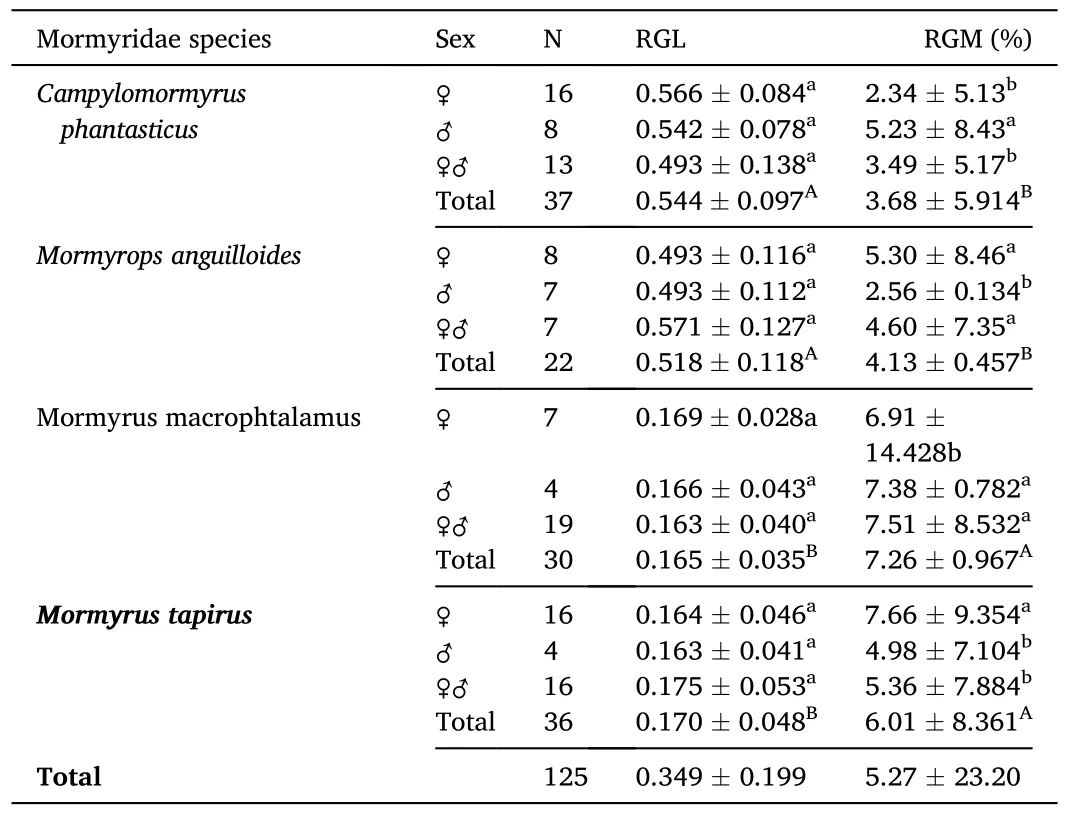
Table 3RGL and RGM of the digestive tract of the Mormyridae fishes according to the species and the sex in the Upper Sanaga River, Central Cameroon.
3.3.Length frequency distribution of the studied species of Mormyridae in the Upper Sanaga River
The size frequency distribution of the Mormyridae population(Fig.3) shows that it was of uni modal type.Fish in size classes 23-26 cm and 26-29 cm were more abundant.The mode was between 23 and 29 cm.The maximum size observed was 43 cm inMormyrops anguilloidesand the minimum observed size was 21.1 cm in the other species.Large fishes 41-44 cm were significantly less represented.
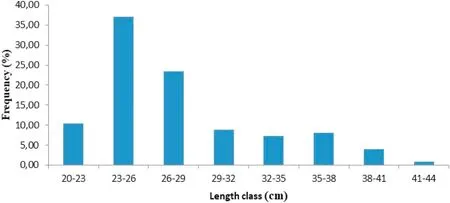
Fig.3.Size frequency distribution of the studied species of Mormyridae in Upper Sanaga River, Central Cameroon.
The size frequency distribution of the studied Mormyridae species according to sex (Fig.4) showed that: Only males are larger than or equal to 43 cm.The maximum size observed in females was in the class 38-41 cm.Individuals with indeterminates sexes were significantly abundant (P <0.001) in the short total length classes.Animals of all sexes were grouped between 23 and 29 cm total length.
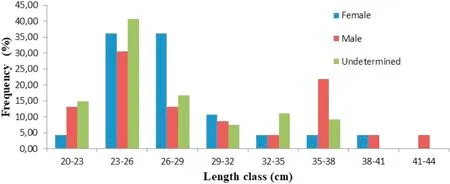
Fig.4.Size structure of the studied species of Mormyridae in the Upper Sanaga River according to sex.
3.4.Reproductive parameters of the studied species of Mormyridae in the Upper Sanaga River
The sex ratio by species is summarized in Table 4.It appears that it varied overall between species.It was generally significant (P <0.001)and in favour of females.However, inMormyrops sanguilloidesit was comparable to unity (1M: 1.14F), inMormyrus tapirus(1M: 4F) it was highly significant (P <0.0001).
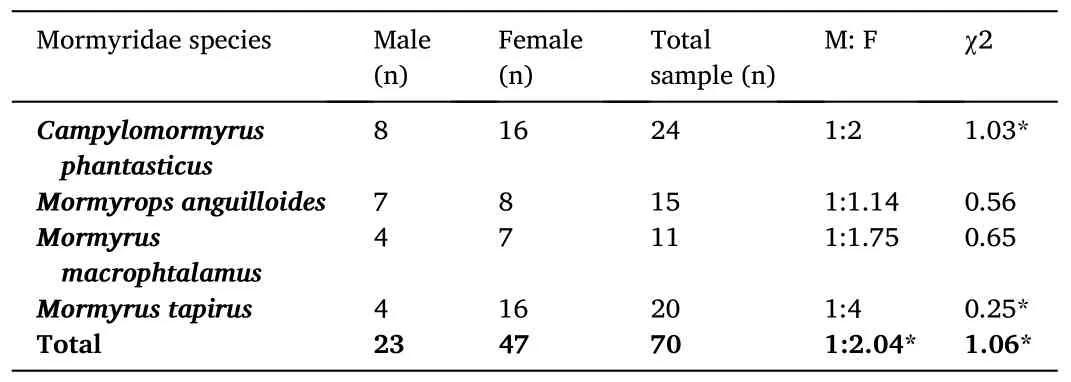
Table 4Sex ratio according to the studied species of Mormyridae of the Upper Sanaga River, Central Cameroon.
The gonadosomatic index of the studied species of Mormyridae of the Upper Sanaga River (Table 5), showed that it was lower (P <0.001) in males compared to females.Furthermore, gonadosomatic ratio of females ofCampylomormyrus phantasticusandMormyrops anguilloideswere significantly (P <0.001) higher than those of other species.

Table 5Gonadosomatic index (GSI) and Hepatosomatic index (HSI) according to species and sex of Mormyridae in the Upper Sanaga River, Central Cameroon.
From Table 5 showing the hepatosomatic index according to the species of Mormyridae, it appears that whatever the species considered,the Hepatosomatic ratio was low.However, it was higher inC.phantasticusandM.tapiruscompared to the other two species, but not significantly (P >0.001).A low and negative correlation (r=- 0.03) was recorded between the HSI and the GSI.The HSI values were higher than those of HSI inC.PhantasticusandM.anguilloides, in contrast toM.macrophtalamusandM.tapiruswhere these parameters were comparable (P> 0.001).
4.Discussion
The present study in the Upper Sanaga River in Cameroon, aims to aid in the preservation of Mormyridae biodiversity through domestication by providing information on feeding habits, size structure, and reproductive characteristics.
The number of identified Mormyridae species (4) at Monatélé (Upper Sanaga River) is lower than that of 18 in the hydroelectric dam project in Nachtigal Upstream in Sanaga River Basin (Bitja-Nyom & Pariselle,2015).This could be due to the fact that the project was spread over a radius of 30 km and used sophisticated materials (local fishermen’s canoes, an aluminum boat hull, battery of monofilament gill fillers) and with two sampling events per day: early morning (5 a.m.) and late in the evening (6 p.m.).In contrary, this study was carried out only on a short stretch of the Sanaga River Basin at Monatélé, with artisanal fishing materials and a fishing rate of twice a month.However, each of these four species of the present study was found in the classification of Stiassny et al.(2007); Bitja-Nyom and Pariselle (2015):Campylomormyrus phantasticus, Mormyrops anguilloidesandMormyrus tapirusare species reported in the Sanaga River Basin by previous studies (Stiassny et al., 2007), whileMormyrus macrophthalmusis a species not previously reported in the Sanaga Basin.Campylomormyrus phantasticusis endemic to the Sanaga Basin whileMormyrops anguilloides and Mormyrus tapirusare native species (Bitja-Nyom & Pariselle, 2015).The relative lowcase composition of the recorded samples is comparable to the results of Bitja-Nyom and Pariselle (2015); this scarcity of fish in catches could be explained by excessive drainage of water and climate change, which leads to a decrease in the volume of water in their beds and consequently the decrease of the number of aquatic species (Brummet & Teugels,2004; Sighomnou et al., 2007).
The value of the relative gut length (RGL) recorded in these species of Mormyridae is much lower than 1, thus classifying Mormyridae as strict carnivorous (Ward-Campbell & Beamish, 2005).According to Cleveland and Montgomery (2003), the values of RGL for species with specific dietary habits that are outside the predefined interval could be an unusual biological phenomenon.However, German and Horn (2006) reported in four species herbivorous and carnivorous prickleback fishes that Ontogeny and phylogeny more than diet appear to influence gut dimensions, thus favouring genetic adaptation over phenotypic plasticity as the major force acting on digestive system features in fishes.The mean value of the RGL (0.324 ±0.199), would mean that the length of the intestine is very small compared to the length of the fish.The structural study of the alimentary canal has shown that the presence of two pyloric caecum in these species is a specific characteristic of all the Mormyridae family (Stéphane, 1967).These results confirm those in the literature which show that in all vertebrates carnivorous have a shorter digestive tract than omnivorous and vegetarians (Karachle & Stergiou,2010; Tiogué et al., 2015).These findings were supported by the construction of the bowel length/length of fish relationship in these Mormyridae (Karachle & Stergiou, 2010; Tiogué et al., 2015) although it was very low in all species.
The relative gut mass (RGM) was out of the margin defined by Buddington et al.(1997), namely (3.00% and 4.00%).The RGM of the Mormyridae fishes was higher than that of 2.5% on average of Turbot(Psetta maximaLinnaeus, 1758) (Carnivorous) (Karachle & Stergiou,2010).According to Buddington et al.(1997), this parameter varies depending on the physiological state of the animal and the nature of the consumed prey.Thus, a carnivorous that consumes hard exoskeleton prey such as crab must have a higher RGM than one that consumes soft prey (Buddington et al., 1997).This shows that in the present study, the Mormyridae fishes also consume hard exoskeleton prey.Moreover,German et al.(2010) showed in detritivorous catfish (Teleostei: Loricariidae), that gut structure and function (i.e.the surface area of their intestines and the microvilli surface area) depends on food quality and quantity consumed.
Mormyridae are a family of freshwater fish from tropical Africa and the Nile basin (Stiassny et al., 2007).According to Bigorne and Paugy(1991) and Stiassny et al.(2007), they can measure up to 1.5 m in length, this is the case ofMormyrops anguilloideswhose maximum size recorded is 150 cm SL (standard length).But the majority have a size of between 9 and 50 cm (Mormyrus macrophthalamus(30 cm SL),Mormyrus tapirus(30 cm SL) andCampylomormyrus phantasticus(65 cm SL).The uni-modal size frequency distribution concentrated on small fish of the Sanaga Mormyridae population showed that the fishing mortality on large fish might be high.This fishing mortality does not vary by sex and also explains their relative low catch composition of samples reported above.These results are comparable to those of Tiogué et al.(2010)recorded in African carpLabeobarbus batesiiBoulenger, 1903 in the Mb? Flood Plain in Cameroon.The maximum size observed in these species was 43 cm LT (inMormyrops sanguilloides).Mormyridae are therefore a large fish.Moreover, this size is much greater than those of 73-100 mm TL recorded in to nine species ofPetrocephulus(Teleostei: Mormyridae)in West African Rivers (Bigorne & Paugy, 1991).According to several authors (Legendre & Albaret, 1991; Fontaine et al., 2009; Tiogué et al.,2010, Tiogué, 2012), large fish species are typical good candidates for culturing in captivity in the tropics.
The sex ratio has generally been in favour of females.This could be corresponded to a reproductive multiplication of a species, and thus an overpopulation (Nzeh & Lawal, 2012).However, this is not the case because the Catch composition of samples has been very low.The sex ratio could be to one sex being harvested more because it grows faster or one sex may simple get larger and be more susceptible to capture.Similar results have been reported in Cyprinidae:Labeobarbus batesiiBoulenger 1903 (1:1.42) in the Mb? Floodplain in Cameroon (Tiogué,2012; Tiogué et al., 2013),Labeo coubieRuppell, 1832 (1: 1.67) in Nigeria (Ikpi & Okey, 2010),Rasbora tawarensisWeber & de Beaufort,1916 (1: 3.39) (Muchlisin et al., 2010), andLiza klunzingeriDay, 1888(1: 2) (Abou-Seedo & Dadzie, 2004).This predominance of females would lead to higher mortality in males, probably attributed to the early acquisition of maturity and rapid growth (Tiogué et al., 2013).Ham(1981) attributes this female predominance to differential survival under certain environmental conditions.It can also be explained by the result of a selective fishing of large fishes preferred by fishermen or phenomena of avoidance and escape of large males against fishing gear(Tiogué et al., 2013).Otherwise, the possibility of temperature’s effect on the sex ratio of developing fish embryo has been shown (Ragheb,2016).These results are contrary to those reported in some teleost fishes where the sex ratio is in favour of males.As for example in MormyridaeMormyrus kannumeForssk?l, 1775 in the Damietta branch of the Nile,Egypt (1.00: 0.42) (Ragheb, 2016); in the Nile at Assiut Egypt (0.84:1)(Mekkawy & Hassan, 2012.) and in Bahr Shebeen Nilotic Cana, Egypt(0.87: 1) (Khallaf & Authman, 2010).Khallaf and Authman (2010)mentioned that the patterns of variations between the populations ofM.kannumeForssk?l, 1775 reflect time and locality factors and refer to the action of natural selection on the overall sex ratio.In ClariidaeChrysichthys nigrodigitatusLacépède, 1803 in the Cross River in Nigeria(1: 0.15) (Abayomi & Arawomo, 1996) and (1: 0.5) (Offem et al., 2008);Chrysichthys walkeriGünther, 1899 (1: 0.80) in the Lake Asejire (Taiwo& Aransiola, 2001) andClarias anguillarisLinnaeus, 1758 (1: 0.6) in the Cross River in Nigeria (Offem et al., 2010).In CyprinidaeGarra rufaHeckel, 1843 (1.10: 1) in Central Iran (Abedi et al., 2010),Barbus grypusHeckel, 1843 (1.34: 1) in Dam Atatürk Lake, Turkey (Oymak et al.,2008) andLabeo parvusBoulenger, 1902 (1: 0.88) in the Ouémé River basin in Benin (Montchowui et al., 2011).The results obtained in this study are different from those of Fagade and Adebisi (1979), who explained this phenomenon inChrysichthys nigrodigitatusLacépède,1803 by the fact that males still predominate in fish populations in the African rivers because they generally grow faster than females, without any risk to the fisheries.
The GSI and HSI were low regardless of species considered.These data collected over a short period did not allow to define the breeding season in these Mormyridae.Indeed, the evolution of the GSI, HSI and condition factor K of a given species determines the breeding season of the species (Tiogué et al., 2013).It would therefore be important to spread this study throughout the year to determine the breeding season of Mormyridae in this area.
5.Conclusion
At the end of this study on some biological aspects of the Mormyridae fishes in the Upper Sanaga River in Cameroon, the main conclusions are as follows: Four species of Momyridae described in the literature have been identified:Campylomormyrus phantasticus, Mormyrops anguilloides,Mormyrus macrophtalamusandMormyrus tapirus.Their catch composition of samples was very low (<30%).They recorded a mean relative length and mass of the digestive tract of 0.349% ± 0.199% and 5.27% ±23.20%, respectively; thus showing a strict carnivorous diet consuming preys difficult to digest.
Length frequency distribution by sex or species showed that small fish were the most abundant in catches of all species.The maximum size observed ranged from 41 to 43 cm, thus showing that these species can reach large sizes.
The sex-ratio was in favour of the females in all species.GSI and HSI were lower in all species.Data collected within a short period of time did not allow us to determine the breeding season of these species.As a perspective, one should Expand the collection sites for fish sampling in order to identify all the of Mormyridae fish species in this area.
Declaration of competing interest
Authors have declared that no competing interests exist.
Acknowledgements
The authors grateful to fishermen who helped collecting the data in the Upper Sanaga River.
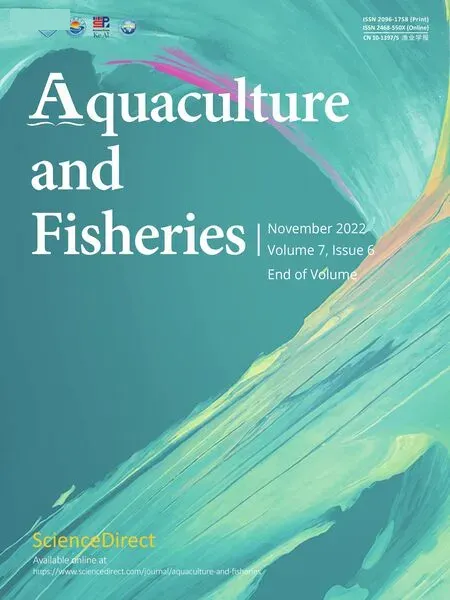 Aquaculture and Fisheries2022年6期
Aquaculture and Fisheries2022年6期
- Aquaculture and Fisheries的其它文章
- Impact of anthropogenic activities on changes of ichthyofauna in the middle and lower Xiang River
- Comparison for ecological economic performance of Chinese sea perch(Lateolabrax Maculatus) under different aquaculture systems
- Environmental variables affecting the gillnet catches and condition of Labiobarbus festivus and Osteochilus hasseltii in northern Malaysia
- Genetic diversity and relatedness inferred from microsatellite loci as a tool for broodstock management of fine flounder Paralichthys adspersus
- Retention of fin clips and fin and operculum punch marks in rainbow trout
- Hybrids production as a potential method to control prolific breeding in tilapia and adaptation to aquaculture climate-induced drought
